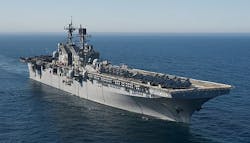BAE Systems to provide electronically steerable IFF antennas for surface warship air defense
Officials of the Naval Air Systems Command at Patuxent River Naval Air Station, Md., awarded BAE Systems a $12.1 million contract modification Friday to provide eight OE-120 electronically steerable antenna (ESA) groups.
These air traffic control radar antennas are suitable for the Ticonderoga-class cruiser (CG 47), the Arleigh Burke-class destroyer (DDG 51), the Wasp-class amphibious assault ship (LHD 1), the San Antonio-class amphibious transport dock (LPD 17), aircraft carriers, and the Japanese Kongo-class destroyer (FMS DD 173) -- a version of the U.S. Burke-class destroyer.
The AN/UPX-29 shipboard interrogator is a centralized IFF system that employs a challenge and reply technique to distinguish friendly platforms in a multi-target environment.
The BAE Systems OE-120 antenna group is an electronically steerable antenna that shipboard operators can redirect within 50 microseconds to interrogate any target on the horizon. The antenna array supports IFF interrogator as well as air traffic control beacon systems, and is designed for surface ships and land-based installations.
Friday's order is to provide OE-120(A)/UPX antenna groups for use on Arleigh Burke-class destroyers hull numbers 119 through 122, as well as for amphibious assault ships, and for the U.S. Missile Defense Agency.
At the heart of the OE-120 is the AS-3134/UPX antenna array, which consists of 64 vertical radiating dipole antenna element pairs arranged in a circle on the ship's mast. The system uses electronic beam steering to scan all areas around the ship. The dipole antenna element pairs can produce either directional or omnidirectional beam patterns.
The system can aim its RF energy at any target of interest located at any point on the horizon within microseconds. Operators also can scan the antenna's output rapidly over a designated sector of interest. During normal surveillance operations the antenna group scans the horizon at 90 revolutions per second.
The OE-120's CV-3372/UPX antenna positioner receives commands from the C-10063/UPX controller, distributes RF power to the radiators, and digitally controls the system's output mode and boresight direction. The system's C-10063/UPX antenna controller, meanwhile, is located below decks and translates synchronized data continuously from the ship's environmental sensors.
The OE-120 antenna group is designed to work with the Navy AN/UPX-29 stand-alone IFF system, which can process and store as man as 400 targets, provide instantaneous interrogation on a target within 25 microseconds, electronically evaluate Mode 4 replies, call up operator-designated target information, display IFF targets synchronized with as many as four radars at 22 displays, and interface with shipboard computers.
The AN/UPX-29 primarily uses is processor controller and the OE-120 antenna group. If the main processor or OE-120 antenna should fail, the ship switches over to a backup processor and backup rotating antenna.
The original BAE Systems contract for these antennas was a $30 million order on 29 May 2015 for six OE-120(A)/UPX antenna groups for the Navy. Last December the company won a $7.6 million order for five of the antenna groups. With Friday's order the contract comes to a total value so far of $49.6 million.
On the OE-120 antenna contract, BAE Systems engineers will do the work in Nashua, N.H., and should be finished by March 2020. For more information contact BAE Systems Electronic Systems online at www.baesystems.com/Businesses/ElectronicSystems, or Naval Air Systems Command at www.navair.navy.mil.
